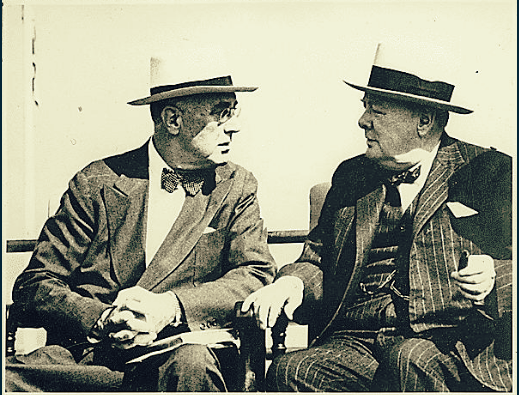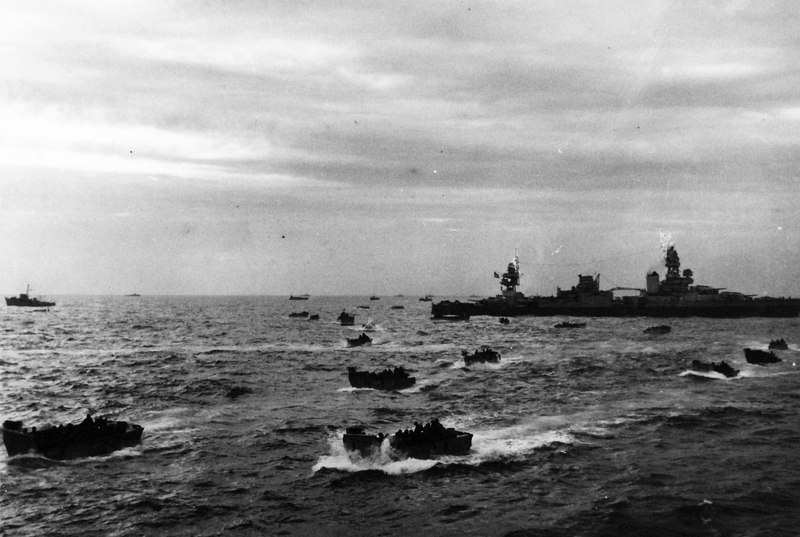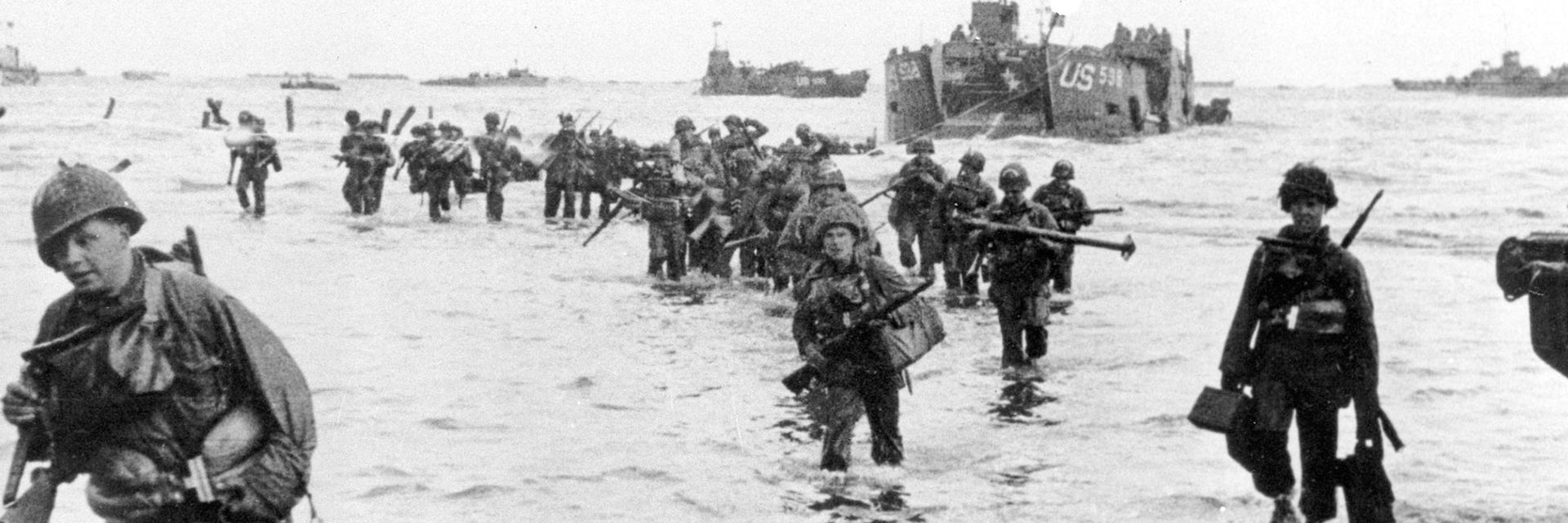Editor's Note: To mark this year's Memoral Day in the United States, we are republishing this article that was originally posted to commemorate the 75th anniversary of D-Day during World War II.
◊
D-Day and its military consequences turned the tide against Nazi control of Western Europe. In fact, the decision to invade Normandy, in that massive manner, is seen by many as the most important strategic decision of the struggle against the Germans in World War II. Despite many setbacks on that hard-fought day, Allied inventions and advances in military equipment, from landing craft to fake inflatable tanks, ended up turning the tide to victory for the Allied forces.
◊
D-Day is now 75 years behind us, but looking back at this historic event should still give us pause. The invasion was an absolutely massive undertaking, moving more than 150,000 Allied troops onto enemy-held territory, along with enough equipment and supplies to meet the troops’ needs for a long struggle.
Thousands of tons of equipment and supplies traveled with the troops, from landing craft and beach-clearing tanks to food, medical equipment, and other personal-use materiel, including 3,500 tons of bath soap, matte-black Zippo lighters, sugar cubes (for coffee), and packs of cigarettes for all the troops (since it seems just about everybody in the military smoked back then). So many K-rations were sent across the English Channel that they had to be packed in 500-ton bales.
Landing craft were mass-produced to carry troops and equipment from the sea to the shore over hundreds of yards of deep water. As this was the largest military landing of its type ever planned by an invasionary force, many types of specialized craft had to be designed. These included lightly armored transit vehicles for personnel (LCVP, or Landing Craft, Vehicles/Personnel), called “Higgins boats”; others developed for tanks (LCT); and still others to carry other military vehicles, ammunition, and supplies.
_43.png)
Normandy landings. (Image courtesy of Supreme Headquarters Allied Expeditionary Forces, via Wikimedia)
Landing Craft for Every Military Need
Landing craft were vitally important to the troops, their supplies, and the overall strategy of the mission. According to some accounts, there were nearly 6,900 ships and landing craft deployed on that day.
The landing craft were developed by the U.S. military in the run-up to war. They had an inherent advantage over their predecessors – primarily rowboats – to get military personnel and supplies from ship to shore. One feature most of these vehicles had in common was the inclusion of a bow ramp that would drop down at landing to allow rapid exits. Some of these craft were armed with rocket launchers to provide cover for their passengers; others were designed to allow tanks to fire their weapons from the craft toward German strongholds. More than 4,000 landing craft were involved in the invasion.
Unfortunately, on D-Day, many of the Higgins boats got stuck on sandbars and disgorged their passengers in choppy water up to their necks. A distressingly large number of soldiers drowned before even reaching shore, and some others were picked off by German machine gun fire and snipers as soon as they emerged from the surf.
But all the landing craft in the world could not have succeeded without a grand strategic plan and its proper execution.
A Year of Planning for a Fateful Day
Planning for this incredibly ambitious and risky undertaking started a year earlier with conversations at the highest levels of the Allied military leadership, along with British Prime Minister Winston Churchill and U.S. President Franklin Roosevelt also personally involved. General Dwight Eisenhower was entrusted with commanding the overall military plan, codenamed Operation Overlord, as head of the Supreme Headquarters Allied Expeditionary Force. British Army General Bernard Montgomery was named to lead all Allied ground forces for the campaign.
A clear and strong response to Europe’s subjugation under the thumb of Nazi Germany was seen as essential. And the Soviet Union, fighting the Germans on the Eastern Front, urged its U.S. and British allies to open up a Western Front to force Hitler to defend Germany from both directions.

Winston Churchill and FDR in Canada, on September 12, 1944.
(Image courtesy of Franklin D. Roosevelt Public Library, via Wikimedia)
Not everyone was sanguine about the choice of Normandy as the site of the invasion. Some, including Churchill, harbored concerns about the viability of this approach in this location, especially as Allied invasions in the south of France and Italy were showing signs of success.
Churchill eventually signed on to the plan, however, and then the challenge was, above all, to keep the audacious plan secret from the Germans – and equally important, to organize the operational success of the invasion and the follow-up push toward Germany itself.
But there was another factor that was much on Allied planners’ minds: the optimal timing and conditions for the amphibious invasion.
Predicting Tides Serves a Key Role in D-Day Planning
In late 1943, British mathematician Arthur Doodson was contacted by a friend in the Royal Navy to participate in a top-secret project to predict tidal movement for a location described only as “Position Z.” Doodson had spent a good portion of his career studying and predicting tides and, as head of Liverpool’s Tidal Institute, had participated in the invention of a successful tidal forecast machine that had already assisted British troops in their invasion of the south of France.
Doodson was supplied a table of tide heights for this secret position and given a series of other imperatives for the task. To the best of his ability, Doodson was to select a landing date and time that encompassed three key factors: a full moon and clear skies, calm seas, and low tide. Following a series of complex calculations, Doodson reported his results. The best dates for all conditions to be met was between June 5th and 7th, and he calculated the low-tide hours to pinpoint the best time for troops to land.
The importance of Doodson’s calculations can’t be overstated. Despite problems that developed on the actual landing date and times, Doodson’s tide prediction machine successfully pinpointed the optimal times for the Allied landing.
If only the weather had cooperated.

Normandy Invasion, U.S. Navy Ships, June 1944. USS Augusta (CA-31) off French Invasion coast, probably Omaha Beach, during landing operations.
(Image courtesy of National Museum of the Navy, via Wikimedia)
Despite the hope – and plan – for clear weather, as June 6th approached it became apparent that there would be storms and wind on that day. Numerous voices of caution were raised, for the weather was of vital concern. Even German Field Commander Erwin Rommel, whose intel on Allied troop movements tipped him off that something was likely to happen in early June, predicted that the Allies would not be able to land in Normandy due to the inclement weather. Acting on this belief, Rommel moved a portion of his troops from Normandy to other sites that he considered more likely for the coming invasion.
Allied troops divided up the 50 miles of Normandy coastline into five beaches, and split responsibility among the major players. The U.S. took responsibility for Utah and Omaha beaches, at the far west of the invasion zone. On the eastern side were two zones assigned to the British Army, Gold and Sword beaches. Juno Beach, situated between Gold and Sword, was primarily the concern of the Canadians.
D-Day and the Innovative Equipment that Made it Possible
Much is made of the “fog of war,” and, despite the planners’ best efforts, that fog fell heavily on Operation Overlord. For example, plans were made to ease the rigors of landing in numerous ways. Scores of B-24 Liberator bombers were sent on raids along the coastline, but predawn sorties missed their marks and hit too far inland to be helpful to the landing troops. Rather than “softening” the German targets, the errant raids left landing forces exposed to German shelling and machine gun fire upon the open and vulnerable flat stretch of the landing sites.
On D-Day, two enormous devices called Mulberry Artificial Harbors were transported to the Normandy coastline to serve as critical elements for moving massive amounts of equipment to shore as the invasion progressed. The components of these structures consisted of decommissioned naval vessels that were deliberately sunk near the shoreline to form breakwaters, and two sets of floating concrete sections that in essence formed manmade “piers.” They extended from the beachline to a safe distance from which to load and unload cargo, including even the heaviest of tanks.
Although the “Mulberries,” as they were called, obviously could not be in place for the day of the invasion, both artificial harbors were operational within 12 days to allow for easy evacuation of the wounded, as well as continued shipments of equipment and supplies.

Normandy Invasion, Mulberries, June 1944. (Image courtesy of National Archives and Records Administration, via Wikimedia)
In addition to these practical equipment innovations, the Allies also made use of ingenious deceptions to fool the Germans. For example, during preparations for Operation Overlord, clever tacticians created faux inflatable tanks and other vehicles, and positioned them in areas that had been vacated by the real equipment that was being massed near the embarkation ports. And the ruse worked! Rather than seeing empty fields where the equipment had been gathered, the German analysts of aerial reconnaissance photos were tricked by these fake blow-up structures that, from above, could not be distinguished from their deadly counterparts.
Another bit of trickery was employed when, the night before the invasion, cargo planes dropped hundreds of dummy paratroopers, called “Ruperts,” many miles east of the invasion site to confuse the Germans. Upon landing, the Ruperts loudly fired off blank ammunition to lure German defenders away from the Normandy beaches and real paratroopers’ landing zones.
Giving the Green Light: Eisenhower’s “Greatest” Wartime Decision
Speaking at a press conference in 1947, General Eisenhower was asked what his “greatest” military decision was – not just relating to D-Day, but of his entire career. After some thought, he talked about serious misgivings he had considered for the potential failure of Operation Overlord. But after considering all the information at his disposal, Eisenhower gave the go-ahead. He gave personal sendoffs to several companies of airmen, but when given a cup of coffee, his hands were trembling so greatly an aide took the coffee from his hands. He told the reporters, “I let the order stand. . . . The airborne boys did their job.”
We may not fully appreciate those simple words and the courageous actions they summed up. But 75 years after these historic events, it’s important to remember that the outcome of the D-Day invasion was not assured – especially in real time as the operation unfolded. It took the commitment of one man, leading more than 150,000 Allied forces, to take all the possibilities into consideration, and then make the irrevocable decision that ultimately led to victory.
Despite the many casualties of D-Day – well over 4,500 Allied forces died on June 6th – the objectives were sound, the strategy was successful overall, and the Second World War in Europe was shortened as a result.
Hedgerow Hell brings many stories of D-Day to life. From war room calculations to the logistics of landing on Normandy, this historical documentary provides the sights and sounds that added up to one of the most crucial days of World War II.
Ω
Kevin Martin is Senior Writer for MagellanTV. He writes on a wide variety of topics, including outer space, the fine arts, and history. He has had a long career as a journalist and communications specialist with both nonprofit and for-profit organizations. He resides in Glendale, California.
Title image courtesy of Robert F. Sargent, National Archives and Records Administration, via Wikimedia.

